Canon EF 24-105mm f/4L IS USM Lens Review
A zoom lens is always an exercise in compromise; do you go for a fast aperture that limits the zoom range, or a slower aperture that allows the lens to have a longer range and be lighter? The EF 24-105mm f/4L IS USM is the middle option of the trio of lenses that Canon has released that address that question.
Build & Handling
While I wouldn’t call this lens a tank, but it’s no slouch in the build department either. It’s smaller and lighter than a 24-70mm f/2.8, but a lot of that comes from not needing as many large elements because of the f/4 aperture.
The EF 24-105mm f/4L IS USM, weighs in at 23.6oz ( 670g), lighter than either Canon’s 24-70mm f/2.8L USM at 33.3oz (950g) or the new EF 24-70mm f/2.8L II USM at 28.4oz (805g), but heavier than the new EF 24-70mm f/4L IS USM at 21.2oz (600g). The weight savings over the 24-70mm f/2.8s makes this a considerably nicer lens to carry for long periods, especially if you’re not in a situation where you need the faster aperture. On the other hand, for a mere 2.4oz more weight you’re getting 50% more zoom on the telephoto end compared to the newer 24-70mm f/4L.
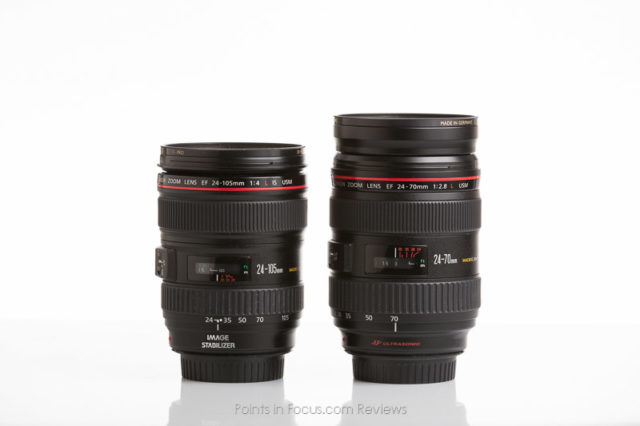
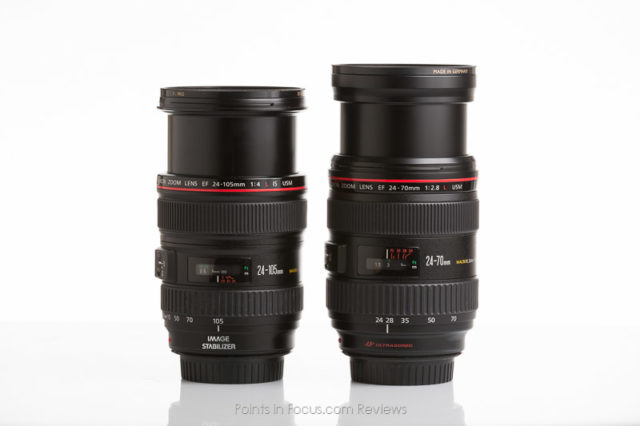
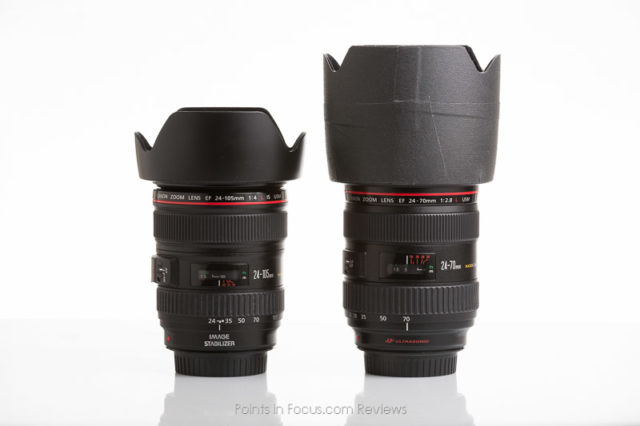
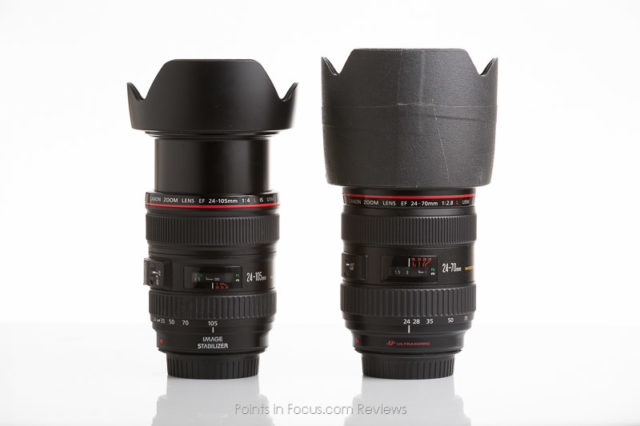
The same as almost all L lenses released since the mid-90s, the EF 24-105mm f/4L IS USM is sealed to protect against dust and weather. Though not water proof, the lens will happily shrug off drips, and light rain.
On a camera, this lens balances quite nicely, even with a lighter weight un-gripped prosumer body like the EOS 6D or EOS 60D.
The focus and zoom rings are very smooth and well damned, as you would expect from an L lens. This lens follows the “standard” layout for a professional lenses; that is the focus ring is towards the front and the zoom ring is close to the camera body. I’ve never been enthralled by this arrangement as on some lenses, I’ve found I can accidentally throw the focus off because of how I hold the lens while shooting. That said, I haven’t really had that problem with this lens.
The zoom design follows the standard practice of extending as the focal length increases. As a result, the lens hood only provides maximal shading at 24mm, and less so as the focal length increases. Because of this, one has to be careful when shooting towards potential sources of flare at longer focal lengths.
Personally, while I like the reverse zoom design used in Canon’s EF 24-70mm f/2.8L USM, since it gives me good shading at all focal lengths, it does make the lens more unwieldy, and especially makes the lens hood massive and harder to deal with when not attached in the shooting position. That said, given lighter and smaller or bigger and heavier, I’m more inclined to go with the smaller, lighter option.
Additionally the EF 24-105mm f/4L IS USM uses a single inner lens barrel. Besides the weather sealing benefits of having only 1 inner barrel, it also makes the feel of the zoom ring much more feeling across the entire zoom range; there are no focal lengths that are more difficult to zoom to on this lens.
Lens and Image Performance
Like most of my lens reviews, this review lacks hard quantitative performance numbers. The simplest reason for this is money, namely getting good measurements requires investing a considerable amount of money into test charts, hardware, and software. Moreover, to get a real good picture at the performance of a lens, you have to test far more than one sample, which means things get very expensive very quick.
For the nitty-gritty details in a quantitative format, DXOMark’s numbers provide a lot of insight into the performance of the lens. However, for a statistically relevant prediction of how good your copy might be you need to look at a more diversified source, such as the numbers Lens Rentals publishes for their fleet of copies.
Qualitatively, I find the biggest annoyance with this lens is the vignetting. At 24mm, even stopped down to f/22, there’s still more than 2/3rds of a stop of vignetting in the corners, wide open the corners approach 2 stops. Fortunately, modern bodies and RAW processors can compensate and remove the vignetting from the resulting images rather easily and with good results.
Maximum magnification isn’t anything to write home about; unaided, the EF 24-105mm f/4L IS USM tops out at 0.23x at 105mm. That can be improved by adding either extension tubes or a close up lens. With a 12mm extension tube, the max magnification increases to 0.6x at 24mm and 0.4x at 105mm. With a 25mm extension tube, the max magnification increases to 0.61x at 105mm.
Autofocus
Auto focus performance is quite good. The lens can drive the focusing group over its full range in about 1/3rd of a second when hunting, and with acceptable contrast to lock on to a subject; the acquisition time is fast enough to be inconsequential.
The autofocus system on the 24-105mm f/4L IS USM is extremely well behaved. Accuracy, at least in my experience with my copy, is quite good and very consistent from shot to shot. Moreover, I haven’t seen any significant errors or varying performance in focusing either on my 5D mark III or my EOS-1D mark III.
Stabilizer
The EF 24-105mm f/4L IS USM as its name implies, is equipped with an image stabilizer. Dating from 2005 the stabilizer is capable of reducing camera shake allowing for shutter speeds up to 3 stops slower than the hand holding rule of thumb would suggest.
When shooting video the image stabilizer works continuously and does a respectable job at reducing camera shake, especially at longer focal lengths.
Video
Since the release of the EOS 5D mark II video has increasingly become relevant for SLR users and SLR lenses. With respect to video performance, there are two considerations that I find are the most significant factors for a lens’s suitability for use in video situations; breathing and parafocal performance.
Breathing is the undesirable behavior where a lens’s field of view changes as the focus is changed—the edges of the frame literally breathe in and out while pulling focus. Unfortunately, breathing is not especially well controlled with this lens. It’s most obvious at 24mm, though at 105mm it still exists.
The second case is parfocal behavior. Parfocal behavior is a requirement for being able to pull zoom while shooting properly. A parfocal lens is one that maintains the focus point at exactly the same distance when the focal length is changed. For still lenses, Canon doesn’t officially recognize lenses as being parfocal so there’s no official word. However, I’ve seen a number of user-generated lists, and this lens is never on them. In my own testing, I don’t find this lens to have parfocal or near parfocal behavior either.
That said, due to the f/4 aperture and wide working range it’s very hard for me to accurately gauge a focus shift when zooming from 105mm to 24mm. The massive increase in depth of field change in size due to the increase in angle of view covers up any error that occurs due to non-parfocal behavior. As a result of the difficulty of that I’ve omitted the test from the video sample above.
The focus ring has a short-for-video throw of about 135°. A 300-degree throw would be preferable, that’s simply not in the design cards for AF still lenses. Additionally the ring-USM design doesn’t have hard focus stops, which while fine for stills will require a follow-focus that provides hard stops to insure repeatable movements.
While some might debate the utility of image stabilization, I’m not one of them, and for hand held video stabilization is especially handy.
Alternatives
As a general-purpose zoom lens, the EF 24-105mm f/4L IS USM is in the company of only a handful of other lenses.
For the budget conscious the EF 28-135mm f/3.5-5.6 IS USM is the only current offering for a non-L general purpose zoom lens. I’ve reviewed it here (INSERT LINK). In general it’s a decent lens, if you’re unwilling to spend the premium for the L glass, but otherwise isn’t especially impressive. I certainly wouldn’t trade a 24-105 f/4L for a 28-135.
Canon has recently announced a new EF 24-70mm f/4L IS USM. In its favor, the new EF 24-70mm f/4L IS USM, is slightly smaller, slightly lighter, a much higher maximum magnification, a slightly better IS system (4 stops instead of 3), and it’s very slightly better optically. On the other hand, reducing the longest focal length from 105mm to 70mm reduces the reach of the lens by a third. Moreover, if that all sounds great, it comes at a $350 higher price tag. Personally, though some of the updates in the new 24-70mm f/4L could be nice, I’d much rather have the reach the 24-105 gives me.
The final option is to step up to a 24-70mm f/2.8 lens. Either the newest one from Canon the EF 24-70mm f/2.8L II USM, or the older EF 24-70mm f/2.8L USM, or a 3rd party lens like the stabilized 24-70mm f/2.8 form Tamron. Excepting the Tamron, the 24-70 f/2.8s provide a stop faster aperture, which can make all the difference in low light situations with moving subjects. On the other hand, it has the same problem the 24-70mm f/4L does with respect to reach, and again excepting the Tamron, isn’t stabilized necessitating a stable shooting platform when shooting video.
In the end, I find the EF 24-105mm f/4L IS USM to be a very good balance of value, performance, and functionality. It doesn’t especially excel in any area, nor does it really lag either; what it does, is produce solid images over a wide range of use cases on a reasonable, for an L lens at least, budget.



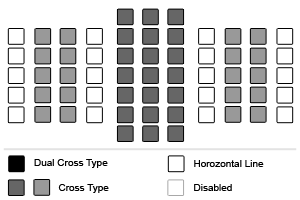
Comments
There are no comments on this article yet. Why don't you start the discussion?